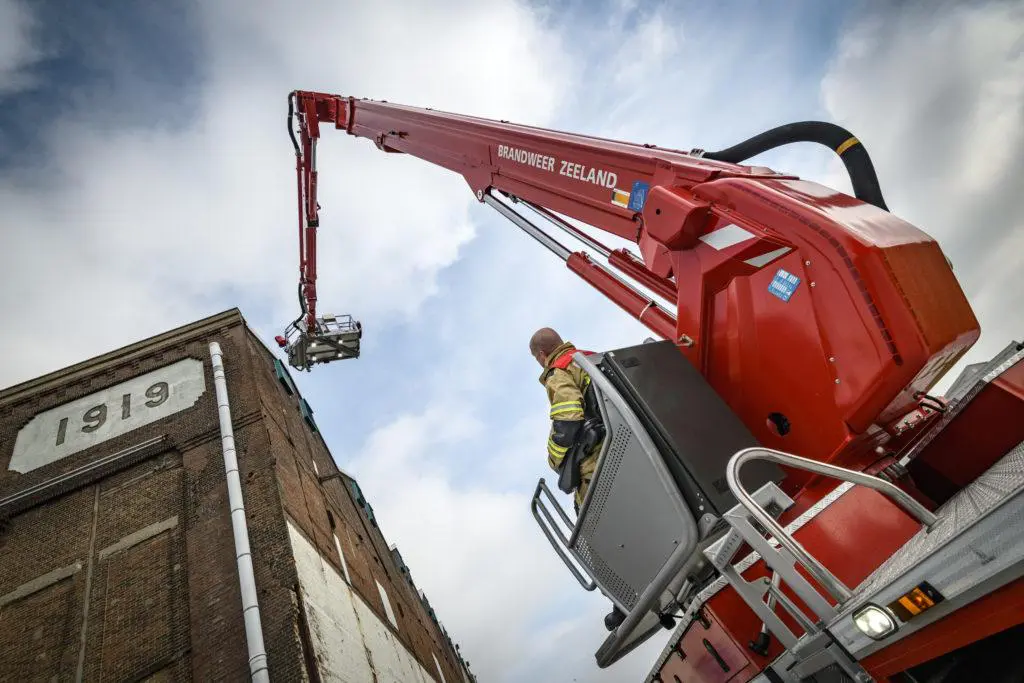How can industrial and municipal fire brigades benefit from having aerial platforms in their fleet? What can aerial platforms offer to the continuously evolving industry? We sat down with Roberto Quintero, director of Marketing, Sales, Project and Product Management here at Bronto Skylift to tackle these questions and talk about the benefits of aerial platforms for firefighting.
What are the benefits of an aerial platform?
The single most important benefit is versatility, which can be seen in many ways. Aerial platforms allow deployment in a variety of missions, as they can be used for actual firefighting and rescue operation, as well as e.g. clearing up storm damages, rescuing animals from high structures, or even lifting vehicles from rivers and ponds. Furthermore, their versatility can be seen within a firefighting and rescue mission; an aerial platform can reach not only up, but sideways, beyond an obstacle and downwards as well. Integrated water, foam and dry powder lines enable fighting different fires, while the spacious rescue cage enables bringing injured or disabled persons to safety with a wheelchair or a stretcher. Various camera options allow increased situational awareness and remote controls enable firefighting from a safe distance and so forth. All with one single vehicle.

How do you customise solutions for different environments?
Customisation is as heavy or light as our customer defines, and it is safe to say that almost all our aerials are tailored to some extent. When you take all different legislations, standards and local requirements and combine that complexity with the specific needs of a single fire brigade, it is quite a variety of solutions – some more complex than others. Typically, the aerial platforms for industrial fire brigades at oil refineries, chemical factories or nuclear power plants have the most complex requirements. Safety precautions in these kinds of complex industrial areas are very strict and the fire prevention and protection plans are extensive. This kind of environment may require anything from specific vertical or horizontal reach to extremely high-water capacity and tailored foam systems. Normally these units have strong surveillance capabilities and remote controls as well. We sit down with the Fire Chiefs and go through what they need and what kind of solution best accommodates their fire prevention and fighting, as well as rescue plans. Whether it is an industrial plant or a municipal fire brigade specification, it is always a matter of finding the best solution to fit the purpose.

How do you stay innovative in a continuously evolving industry?
Our customers do a great job keeping us innovative on a daily basis. When working so closely with our customers and preparing tailored solutions for their needs, we get a good understanding of the current trends. That being said, new technologies emerge all the time and new challenges are faced as we go forward, so we must keep a keen eye on how requirements evolve and how new technologies may play a role to serve future needs. Our company soon celebrates 50 years in business. Looking back, we can say we’ve been quite innovative in the past 50 years and we are not going to stop here.
What types of fires can aerial platforms tackle?
That depends a lot on the aerial platform and its capabilities. An aerial platform can have, for example, water, foam and a dry powder line to allow an efficient response for different types of fires, or it can just have an efficient water line and human rescue capabilities depending on the environment where it serves. Also, the height of an aerial platform can be anything from 20 metres to over 100 metres. In general, it can be said that aerials are best serving in tasks where you need to fight fires up high or otherwise difficult-to-reach locations or in places with risk of explosion, for example, where the fire fighting needs to be done at a safe distance. High buildings, complex structures, buildings behind roofs or parapet walls, industrial plants, ports and shipyards, etc.
How can you ensure standardisation and quality in your products, are there certain regulations you have to adhere to?
As a company, we are fully ISO9001 and ISO14001 certified and closely monitor our quality practices. Our aerials are critical equipment, and when they are deployed, human lives are often at stake. This is a commitment we don’t take lightly. All our fire & rescue aerials are designed and manufactured according to the European standard for vehicle-mounted hydraulic platforms for firefighting and rescue services, the EN1777. Also, as previously mentioned, there are quite a lot of local rules and regulations in different countries, so we prepare our aerials to comply with requirements of the final destination.
What is the highest aerial work platform you provide and what can these be used for?
NFPA defines high-rise buildings as being higher than 23 metres or about 7 stories, so most of our products are by definition suited specifically to high-rise building applications. However, our internal definition of high-rise building applications starts at heights above 70 metres. These applications are served by our HLA -range, which includes aerials from 78 to 112 metres, especially in cities with older high-rise buildings that are not equipped with fixed fire suppression systems or for which evacuation can be challenging.
However, the HLA range also serves some specific industrial fire applications, such as oil and gas refineries, where the capability to spray water or foam horizontally across distances in excess of 100 metres is needed, or where access to high structures is needed.


